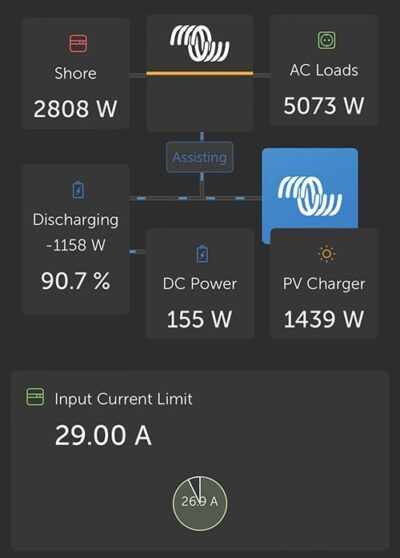I used to think the answer was “it depends”, but the longer I own my Tesla, the more I think the answer is yes.
The Options
In our situation I have always thought the answer was yes, and it has to do with how we go about it. We have 2000 watts of solar panels on the roof, a 5000-watt inverter as well as a 1200-watt inverter, and 900 ah of battery capacity. When we need to charge, we just unplug our RV and plug our Tesla in, using the RV’s solar to stay comfortable while we charge. Since electricity is included at most RV parks, this works quite well for us. I’ve always thought of it as a trade off. We run our RV off of the sun and use the electricity from the RV park to charge the car. It’s clean and simple but not a solution most have access to.
I have spoken with other Tesla RVers who use both the 50-amp and 30-amp circuits at the same time, but they do it in such a way as to not overload the pedestal if it’s one of the older ones not wired for concurrent use. They plug their RV into the 30-amp outlet and their Tesla into the 50-amp outlet, which works because the Mobile Connector won’t pull more than 32 amps. In older campgrounds I’d be tempted to drop this to about 24 amps, which is still double the trickle charging rate. This is the least risky way to use both outlets. I tested this method this week and it does indeed work. My advice is to be around to monitor at each RV park you visit until you get the lay of the land. A good EMS/surge is still your best friend regardless.
The Ethics
Non-EV campers sometimes say this isn’t ethical as it costs the campground money. A couple of points to consider:
- Electricity is provided, and RV parks don’t specify how it is to be used. Some people light their sites up like the 4th of July. Some run bitcoin mining rigs. I charge my car. I pay for what that pedestal is capable of providing. If they haven’t priced their sites accordingly, that’s a poor business decision.
- Electricity is an amenity just like the pool, the mini golf course, the bath houses, or the pickleball courts. Not everyone makes use of them all or at all, but our nightly rate routinely pays for benefits we don’t use. It balances out in the end.
- There is nothing unethical about my use of electricity just because it “fuels” my car and other campers have to pay for gas/diesel. I still pay for diesel for our tow vehicle. I know it’s expensive but we all chose our vehicles, hopefully after a lot of research and financial planning. Someone else’s choice to go electric isn’t fair or unfair. It’s just a choice with different pros and cons.
- It will raise prices for everyone. Well, inflation’s here to stay. My car’s charging is but a drop in the ocean comparatively speaking. As long as demand for RV parks exceeds demand, prices will continue to increase.
Nitty Gritty: Consumption Comparison
I have been told that our power draw for our 5th wheel and the Tesla are not nearly equivalent often enough that I did the math. The answer only surprised me because of how close the two were.
Tesla Mobile Connector
The Tesla Mobile Connector with the NEMA 14-50 adapter maxes out at 32 amps at 240 volts, or 7680 watts. In our case, it’s a pretty even swap to run on solar/batteries while our car makes use of the outlet. Note: If you are looking for information on what you need to RV successfully with a Tesla, check out this post on road trip gear.
Our Fifth Wheel
Our rig is a 43′ fifth wheel that uses a 50-amp outlet as stock configuration. That’s 12,000 watts at 240 volts. In the summer, it’s not uncommon to see our system pull 7-8,000 watts or more during the day with all 3 ACs running and us in the rig living life. I’ve been told that this isn’t possible so I offer the screenshot of our Victron energy dashboard. It was taken this morning with 2 ACs, the water heater, and the dryer as well as assorted lights and network equipment up. Our AC load is 5073 watts. That’s before I turn on the 3rd AC or the teens are up with their gaming rigs and playstation. As you can see it’s not hard at all to pull 7-8,000 watts in the summer.
Full disclosure: As I type we are moochdocking on a 30-amp outlet and combining with solar and our battery bank to stay comfortable. I don’t have a 50-amp outlet to show you those numbers, but if anything they’re higher because I’m not combining carefully to avoid tripping the solar/battery system breakers.

As you can see, in the summer, it’s a nearly perfect swap for us. It isn’t unethical. It isn’t costing them anything more than it would if I plugged our fifth wheel in. It’s close enough to be a shrug…unlike the Bitcoin miners and the ones lighting up their site as if it were a runway.
Yes, It’s Ethical to Charge a Tesla at an RV Park
Given the posts above and my 8 months on the road as a fulltime RVer traveling with a Tesla, I see no reason why charging a Tesla at an RV park would be unethical. It is neither dangerous nor an egregious abuse of campground resources. I think that many people overestimate just how much energy it takes to charge a Tesla, and that misconception drives opinions that are simply not based in fact.
Related Links
If you enjoyed this post, check out the related posts below, especially the one on RV park etiquette.